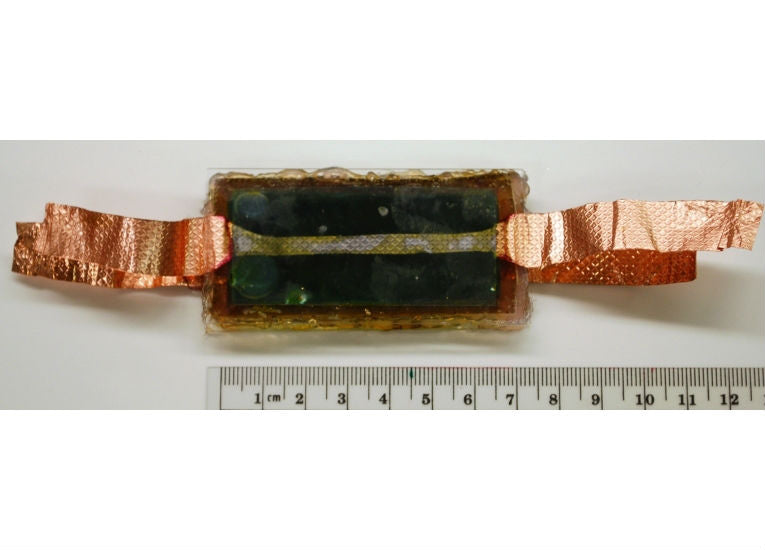American university researchers have discovered a method of combining the photosynthetic protein in spinach that turns light into electrochemical energy with silicon that is used in solar cells.
The combination produces much more electrical current than has been generated by previous biohybrid solar cells, says the team from Vanderbilt University, Nashville.
The study has just been published in the online journal Advanced Materials and Vanderbilt University has applied for a patent on the new method.
Associate professor of chemistry, David Cliffel, says, "This combination produces current levels almost 1,000 times higher than we were able to achieve by depositing the protein on various types of metals. It also produces a modest increase in voltage."
"If we can continue on our current trajectory of increasing voltage and current levels, we could reach the range of mature solar conversion technologies in three years."
David Cliffel worked on the project with chemical and biomolecular engineering professor Kane Jennings.
The team is now planning to use the design to construct a working PS1-silicon solar cell.
Kate Jennings has an award from the Environmental Protection Agency that allows undergraduate engineering students to create the prototype. The students won it at April's National Sustainable Design Expo after they created a solar panel from a two-year old design.
Kate Jennings believes a two-foot panel might generate at least 100 milliamps at one volt - which could power several small electrical devices.
Over 40 years ago, it was found that Photosystem 1 (PS1), a protein involved in photosynthesis, still functioned after it was taken from plants including spinach. Then also discovered that PS1 converts sunlight into electrical energy at almost 100 pt efficiency, whereas manmade devices have conversion efficiencies of under 40%. This meant PS1 could be used to create more efficient solar cells.
Biohybrid cells can also be constructed from cheap and easily obtainable materials, unlike many microelectronic devices that need expensive platinum or indium. Many plants use the same photosynthetic proteins that spinach does and Kate Jennings it also working on another research project to find a way of extracting PS1 from kudzu.
Researchers have found methods of efficient taking PS1 from leaves and have shown that it can be put into cells that generate electrical current when exposed to the sun, but the amount of power the biohybrid cells produce per square inch is significantly below that generated by commercial photovoltaic cells.
Another issue is longevity. The performance of some early test cells fell after a few weeks. But in 2010, the Vanderbilt University researchers kept a PS1 cell going for nine months with no lowering in performance.
David Cliffel says, "Nature knows how to do this extremely well. In evergreen trees, for example, PS1 lasts for years. We just have to figure out how to do it ourselves."
The Vanderbilt University team says its PS1/silicon method generate almost a milliamp (850 microamps) of current per square centimetre at 0.3 volts. This is almost two and a half times more than that of other top-performing biohybrid cells.
This combination works so well because the silicon substrate's electrical properties are specially designed to fit those of the PS1 molecule. This is carried out by 'doping' - using electrically charged atoms implanted in the silicon to change its electrical properties. In this case, the protein worked very well with silicon doped with positive charges but not with negatively-doped silicon.
To construct the device, the team took PS1 from spinach, placed it in an aqueous solution and poured it over a positive p-doped silicon wafer. The wafer was then placed in a vacuum chamber to evaporate the water and leave a protein film of about one micron or 100 PS1 molecules thick.
When a PS1 protein is exposed to light, its photons absorb the energy and free and transport electrons to the side of the protein. This forms areas of positive charge, called holes, which move to the other side of the protein.
In a leaf, all PS1 proteins are aligned, but in the device's protein layer, individual proteins are spread out at random. Modelling previously suggested this might be a big issue.
When proteins are deposited on a metallic substrate those in one direction provide electrons that the metal collects, while those opposite pull electrons from the metal to fill the holes they produce. This means they generate positive and negative currents, which cancel each other out and generated a small current flow.
But the p-doped silicon allows electrons to flow into PS1 and does not accept them from protein, so electrons travel through the circuit in the same direction.
"This isn't as good as protein alignment, but it is much better than what we had before," adds Kate Jennings.
The research was carried out by graduate students Gabriel LeBlanc, Gongping Chen and Evan Gizzie.
The study was financed by grants from the National Science Foundation, EPSCoR and the Scialog Program of the Research Corporation for Scientific Advancement.















